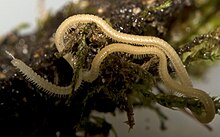Illacme
| Illacme | |
|---|---|
 |
|
| A female I. plenipes with 618 legs | |
| Scientific classification | |
| Kingdom: | Animalia |
| Phylum: | Arthropoda |
| Subphylum: | Myriapoda |
| Class: | Diplopoda |
| Order: | Siphonophorida |
| Family: | Siphonorhinidae |
| Genus: | Illacme |
| Species: | I. plenipes |
| Binomial name | |
|
Illacme plenipes Cook & Loomis, 1928 |
|
 |
|
| Predicted habitat suitability (maximum in blue) for I. plenipes based on climatic variables | |
Illacme plenipes is a siphonorhinid millipede found in the central region of the U.S. state of California. It has up to 750 legs, more than any other animal in the world. One of two species in the genus Illacme, it was first seen in 1926, but was not rediscovered until 2005. The second species, Illacme tobini, was discovered and named in late October 2016.
Although no known millipede species has one thousand legs, Illacme plenipes comes the closest with one recorded specimen having 750 legs. On average, they have over 600 legs, twice the average for millipede species. Despite having more legs than any other creature on Earth, it is actually quite small, even relative to other millipedes. Females grow to just over an inch; males are slightly smaller and have fewer legs.
The species was first discovered in San Benito County, part of the California Floristic Province, in 1926 by federal scientist Orator Cook and formally described by Cook and Harold F. Loomis in 1928. Cook and Loomis described the species without illustration, and it was not until 1996 that the first illustrations were provided by Rowland Shelley of the North Carolina Museum of Natural Sciences, who re-examined the original specimens. However, the species was not seen alive until it was rediscovered in November 2005, almost 80 years after its discovery, by Paul Marek, then a Ph.D. student at East Carolina University. Marek published his discovery in the journal Nature. Marek and colleagues produced a more detailed description of the anatomy and ecology of I. plenipes in 2012.
Illacme is a member of the order Siphonophorida and family Siphonorhinidae. It is the only known siphonorhinid in the western hemisphere, although Shelley suggested more species may be found in Southern California and Mexico. The closest relative of Illacme is undetermined, but a likely candidate is Nematozonium filum of South Africa which shares a long, narrow body shape and characteristics the gonopods.
...
Wikipedia
